
Cliometrica
Scope & Guideline
Pioneering Scholarly Dialogue in Economic History
Introduction
Aims and Scopes
- Quantitative Analysis in Economic History:
The journal emphasizes the use of quantitative methods and econometric techniques to analyze historical economic data, revealing trends and patterns that inform our understanding of past economies. - Interdisciplinary Approaches:
Cliometrica encourages interdisciplinary research that combines economics with history, sociology, and political science, enhancing the depth and breadth of economic historical analysis. - Focus on Historical Case Studies:
The journal publishes studies that examine specific historical contexts, providing insights into the economic mechanisms and outcomes of different eras and regions. - Exploration of Inequality and Economic Development:
Research addressing the themes of inequality, economic development, and their historical trajectories is a core focus, reflecting contemporary concerns about socio-economic disparities. - Impact of Policy and Institutions on Economic Outcomes:
The journal investigates the role of policies and institutional frameworks in shaping historical economic outcomes, offering lessons that are relevant to current economic discussions.
Trending and Emerging
- Economic Consequences of Pandemics:
Recent studies analyzing the impact of pandemics on economic performance and social structures highlight the relevance of historical perspectives in understanding current global health crises. - Climate Change and Economic Adaptation:
Research exploring the effects of climate variability on historical agricultural practices and economic adaptation is on the rise, indicating an increasing awareness of environmental factors in economic history. - Gender and Economic History:
There is a growing focus on gender perspectives in economic history, examining the roles and contributions of women in various economic contexts, reflecting broader societal shifts towards gender equality. - Economic Networks and Globalization:
Emerging themes investigate historical economic networks and their roles in globalization processes, providing insights into the interconnectedness of economies over time. - Technological Change and Economic Development:
Studies analyzing the impact of technological advancements on economic growth and structural changes are trending, aligning with current discussions on innovation and economic progress.
Declining or Waning
- Traditional Economic History Narratives:
There is a noticeable decline in purely narrative-driven economic history studies that do not employ quantitative methods, as the journal increasingly favors empirical analyses. - Focus on Pre-Industrial Economies:
Research centered specifically on pre-industrial economies appears to be waning, possibly due to a growing interest in modern economic issues and their historical roots rather than ancient or medieval economic systems. - Regional Studies with Limited Data:
The journal has shifted away from papers focusing on regions with insufficient historical economic data, as the emphasis on robust empirical evidence strengthens the quality of research published. - Single-Country Studies:
There is a reduction in the number of single-country case studies, as the journal increasingly values comparative analyses that can draw broader conclusions across multiple contexts. - Descriptive Economic Metrics:
Papers relying solely on descriptive statistics without rigorous econometric analysis are becoming less frequent, reflecting a trend towards more sophisticated quantitative research.
Similar Journals
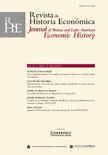
Revista de Historia Economica
Connecting Historical Contexts with Economic RealitiesRevista de Historia Economica, published by Cambridge University Press, is a distinguished peer-reviewed journal that serves as a vital platform for interdisciplinary scholarship in the fields of Economics and History. With an impressive impact factor and ranked within the top quartiles in its respective categories—Q2 in Economics and Econometrics and Q1 in History—this journal stands as a significant resource for researchers and professionals seeking to explore the intricate relationships between economic phenomena and historical contexts. Covering a timeline of research from 1983 to 2024, it addresses both contemporary and historical economic issues, making it an essential read for students and scholars alike. The journal, although not Open Access, maintains rigorous standards of academic excellence and inclusivity, aiming to enhance the understanding of economic history through comprehensive analyses and innovative perspectives. Its esteemed editorial board and qualitative publications ensure that Revista de Historia Economica is at the forefront of economic historiography, attracting a wide readership base in the United Kingdom and beyond.
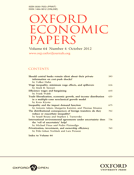
OXFORD ECONOMIC PAPERS-NEW SERIES
Advancing economic thought through rigorous research.OXFORD ECONOMIC PAPERS-NEW SERIES is a prestigious academic journal published by Oxford University Press, dedicated to advancing the field of economics and econometrics. With an ISSN of 0030-7653 and an E-ISSN of 1464-3812, this journal has a rich history since its inception in 1938, and continues to play a vital role in disseminating impactful research through its convergence of years spanning from 1938 to 2024. Recognized as a Q2 journal in the 2023 category of Economics and Econometrics, it ranks #396 among 716 in its field according to Scopus, reflecting a commendable position within the academic community, particularly in global economic discussions. While the journal currently does not offer open access options, it remains committed to providing a platform for rigorous research and critical discourse. Researchers, professionals, and students will find the journal's articles to be essential reading, offering insights that are pivotal for understanding economic trends, policies, and methodologies. Its focus on high-quality scholarship ensures that contributions are both theoretically robust and practically relevant, making it a significant resource in the ever-evolving landscape of economic research.
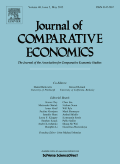
JOURNAL OF COMPARATIVE ECONOMICS
Fostering Innovation in Economic Research Since 1977The Journal of Comparative Economics is a leading academic journal published by Academic Press Inc Elsevier Science, focusing on the field of Economics and Econometrics. With an impressive Q1 ranking in the 2023 Category Quartiles and a robust Scopus rank of #205 out of 716, this journal maintains a prestigious position in the discipline, indicating its significance for researchers and practitioners alike. Since its inception in 1977, the journal has been committed to fostering the advancement of comparative economics by publishing high-quality, peer-reviewed research that explores the dynamics of economic systems and policies across different cultures and regions. Researchers should note that the journal does not currently offer Open Access options, but its rigorous editorial standards ensure that published articles are widely recognized and influential within the field. As the journal converges towards its 2024 volume, it remains an invaluable resource for scholars aiming to deepen their understanding of economic comparisons, effectively bridging theory and application in a global context.
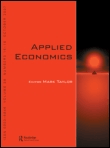
APPLIED ECONOMICS
Fostering Excellence in Econometric ResearchApplied Economics, published by Routledge Journals, Taylor & Francis Ltd, is a revered platform in the field of Economics and Econometrics. Since its inception in 1969, the journal has maintained its commitment to disseminating high-quality research, covering a wide range of topics within applied economics that are critical for understanding and addressing real-world economic issues. With a notable Q2 ranking in Economics and Econometrics and a strong standing in the 67th percentile of Scopus rankings, it serves as an essential resource for researchers, professionals, and students alike, providing insights that bridge theoretical frameworks and practical applications. While the journal is not an Open Access platform, it continues to foster academic discourse and innovation within the economics community, contributing to the ongoing development of evidence-based policies and practices. Its accessibility and robust editorial standards ensure that the latest findings and methodologies reach an engaged audience, further solidifying its reputation as a key publication in the field.
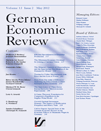
German Economic Review
Connecting Scholars Through Rigorous Economic AnalysisGerman Economic Review is a distinguished academic journal published by WALTER DE GRUYTER GMBH, focusing on diverse aspects of economics and econometrics. With its ISSN 1465-6485 and E-ISSN 1468-0475, the journal serves as a vital platform for disseminating high-quality research from both established scholars and emerging voices in the economic field. Housed in the UK, the journal contributes significantly to the academic community, evidenced by its placement in the Q3 category for Economics and Econometrics in 2023 and its Scopus ranking of #381 out of 716, reflecting its impactful presence in the discipline. German Economic Review does not offer open access options; however, its convergence from 2001 to 2024 indicates a long-standing commitment to advancing economic discourse. This journal is ideal for researchers, professionals, and students eager to engage with contemporary economic theories and applications.
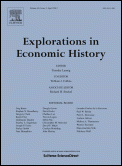
EXPLORATIONS IN ECONOMIC HISTORY
Revealing Economic Dimensions Through Historical LensesExplorations in Economic History, published by Academic Press Inc Elsevier Science, is a prestigious journal that has significantly contributed to the fields of Economics and History since its inception in 1969. With its ISSN 0014-4983 and E-ISSN 1090-2457, this journal has maintained a solid reputation, underscored by its impressive ranking in the Q1 quartile for both Economics and Econometrics and History as of 2023. It serves as an essential platform for researchers, professionals, and students who are keen on unveiling the economic dimensions of historical events and contexts. The journal is indexed in Scopus, attaining a ranking of 61 out of 1760 in Arts and Humanities (History) and 354 out of 716 in Economics, reflecting its significant impact in the academic community. Despite not being an open-access journal, its critical analyses and comprehensive studies provide invaluable insights into the economic phenomena of the past, fostering a deeper understanding of contemporary economic challenges. With committed publication until 2024, this journal continues to be a vital resource for those striving to explore the intricate intersections of history and economics.

CAMBRIDGE JOURNAL OF ECONOMICS
Navigating the Complexities of Economic ThoughtCambridge Journal of Economics, published by Oxford University Press, is a premier academic journal in the field of economic theory, policy, and applications, catering to researchers, professionals, and students alike. With a rich history dating back to 1977, this journal has established itself as a notable contributor to critical discourse in the arena of Economics and Econometrics. With an impressive Scopus ranking of #210 out of 716 in its category, placing it in the 70th percentile, the journal maintains a solid Q2 classification, reflecting its significant impact and contribution to the field. Although it operates on a subscription basis, the Cambridge Journal of Economics is accessible through a range of academic databases and libraries, ensuring that its high-quality research reaches a wide audience. The journal aims to advance the understanding and application of economic principles, making it an essential resource for anyone looking to deepen their knowledge or stay updated with the latest research trends in economics.
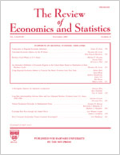
REVIEW OF ECONOMICS AND STATISTICS
Fostering innovation in economic research and analysis.REVIEW OF ECONOMICS AND STATISTICS, published by MIT PRESS, stands as a pivotal journal in the fields of economics and econometrics, with origins dating back to 1978. As a high-impact publication with impressive 2023 rankings placing it in the Q1 category for both Economics and Econometrics, and Social Sciences (miscellaneous), it serves as a crucial platform for scholarly discourse. With an E-ISSN of 1530-9142, the journal provides vital insights and analyses that drive contemporary understanding of economic phenomena. Recognized for its rigorous peer-review process and influential research, the REVIEW OF ECONOMICS AND STATISTICS is essential for researchers, professionals, and students aiming to advance their knowledge and contribute to the field. Though it does not currently offer open access, its substantial impact factor and cutting-edge studies ensure that its articles remain indispensable resources for anyone dedicated to the advancement of economic research.
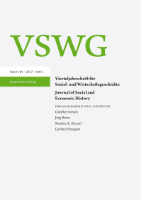
VSWG-Vierteljahrschrift fur Sozial-und Wirtschaftsgeschichte
Illuminating the Complexities of Socio-Economic ChangeVSWG - Vierteljahrschrift für Sozial- und Wirtschaftsgeschichte is a distinguished academic journal published by Franz Steiner Verlag GmbH in Germany, focusing on the interdisciplinary fields of social and economic history. With an ISSN and E-ISSN of 0340-8728, this journal serves as a vital resource for scholars, researchers, and students interested in the complexities of socio-economic transformations across historical contexts. While it currently does not offer open access, its contributions are significant in raising critical discussions within cultural studies and economic history, as evidenced by its Q3 and Q4 rankings in various categories, including Cultural Studies and Sociology. Although the Scopus rankings reflect competitive standings, the journal continues to provide meaningful discourse and insights, supporting academic endeavors in an increasingly interconnected world.

Research in Economics
Pioneering insights for a dynamic economic landscape.Research in Economics, published by ELSEVIER SCI LTD, is a distinguished peer-reviewed journal that addresses pivotal issues in the field of economics and econometrics. Since its inception in 1997, the journal has provided a platform for innovative research and theoretical development, welcoming contributions that push the boundaries of traditional economic thought. With an ISSN of 1090-9443 and an E-ISSN of 1090-9451, it currently holds a respectable position in the Q3 category of the 2023 rankings for Economics and Econometrics. Despite its current Scopus rank of #500 out of 716, representing the 30th percentile, the journal continues to cultivate a rich community of researchers, practitioners, and students dedicated to advancing economic knowledge. While it operates without an Open Access option, the journal remains committed to disseminating high-quality research that informs both academic scholarship and practical applications in the economic landscape.